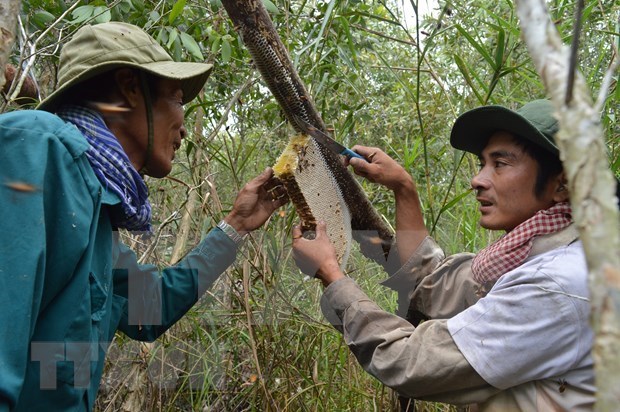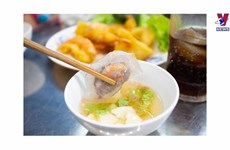Ca Mau’s special apiculture recognised as intangible cultural heritage
The recognition of “gac keo ong” (literally meaning ‘the cultivation of honey bee in the wild’) in the Mekong Delta province of Ca Mau as intangible cultural heritage has created momentum for beekeepers to develop a sustainable business and protect forests.
 "Gac keo ong" is a significant cultural feature of people in U Minh Ha (Photo: VNA)
"Gac keo ong" is a significant cultural feature of people in U Minh Ha (Photo: VNA)Hanoi (VNA) – The recognition of “gac keo ong” (literally meaning ‘the cultivation of honey bee in the wild’) in the Mekong Delta province of Ca Mau as intangible cultural heritage has created momentum for beekeepers to develop a sustainable business and protect forests.
The recognition certification was presented to representatives of U Minh and Tran Van Thoi districts at a ceremony on June 18.
A unique job
Locals said the “gac keo ong”, which is passed on between generations, has been practiced in U Minh and Tran Van Thoi districts since the latter half of the 19th century, when people began developing the areas.
Every year, when cajuput trees are in full bloom, honey bees arrive in droves to build hives on leaning branches. Locals erect leaning tree branches in the forests to lure bees to build their hives, and then wait to harvest the honey.
The branches are often cajuput, about 40 cm in perimeter and two to three metres in length. A layer of wax is applied on the branches to lure bees before being taken into the forest.
Apiculturists use their experience to consider wind direction, sunlight, and the flight paths of the honey bees when deciding the ideal location for the branches. On top of this, the branches should hang at an incline of 45 degrees to ensure sunlight reaches it. It often takes between 20 and 30 days for the bees to build hives.
Beekeepers keep a close eye on their branches to predict when bees will arrive to build hives and how long it will take for the bees to produce enough honey to be harvested.
The best time to erect the branches is between sunrise and 9 am, with the best time to harvest being between 6 and 8 am. Before collecting honey, the beekeepers place smoking kindlings next to the hives, which causes the bees to leave. When collecting the honey, it is important to leave some honey cones, so the bees will return to the hive.
After harvest, the best way to keep the honey is to pour it into ceramic containers and dark glass bottles.
Preserving, promoting value of traditional job
There are about 150 people doing this job in U Minh Ha, which not only generates income for locals but also helps protect to the forest.
U Minh Ha honey is a famous product of Ca Mau province, which is said to offer the best quality. In 2011, the National Office of Intellectual Property of Vietnam credited U Minh Ha honey products as a collective brand.
The practice of “gac keo ong” in the district has also been turned into an eco-tourism product for visitors to experience beekeeping and taste the local honey.
In 1984, local beekeepers established a group to share information and experiences. The group is now a cooperative with many members, and cultivating more than 7,200 hives in a cajuput forest area of 520 ha.
As cajuput forests are part of Ca Mau Cape Reserve Area, members of the cooperative are offered technical training and protective equipment to collect honey and avoid causing forest fires.
During the rainy season, honey collectors can apply traditional methods to collect honey, but during the dry season they have to wear protective clothes and use special equipment to avoid causing fires when smoking out their hives.
After receiving the intangible cultural heritage recognition, authorities of Tran Van Thoi and U Minh Ha districts said they will continue encouraging residents to sustain the job and develop it in connection with tourism for sustainable livelihoods./.













